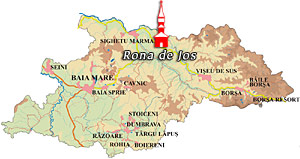Rona de Jos Church

Year built: 1639
Location: Rona de Jos is situated in the valley of the Ronişoara river branch, 12 km east of Sighetu Marmaţiei by the national road DN 18.
Summary: The church of Rona de Jos is the oldest in a series of similar churches in the valley of the Tisa River, three of them in Maramureş, two others in Transcarpathia, on the other side of the river. The main similarity is the nearly closed porch with narrow half-circular openings, but also the building technique and the small number of windows.

Built of oak logs, the church of the Birth of the Holy Virgin has been dated using dendochronological research to around 1639.
In the pronaos, there is also an inscription with the year 1653. Another, slightly later dating for the church is the year 1720, while the wooden altar table can be dated to 1733-34.
The church has not been changed much through the centuries, but the tower roof has been modified at some point. Usually the base of the tall conical roof is square, as is the tower, but here the base of the roof has eight sides. Further, here the roof sits very close to the tower itself, and the usual rather airy balcony seems nearly squeezed under the roof.
The church is rectangular in shape and also the chancel is rectangular, not polygonal as so often. The chancel apse is lower but only slightly narrower than the rest of the church. This type of apse is an indication of the age of the church.

The interior of the church was painted in 1793, and most of the original decoration has been preserved. The scenes are framed with white, red, blue and yellow bands, and are explained by inscriptions in Romanian with Cyrillic letters.
There are several unique icons painted on wood and glass in the church. Some of them date from 1817 and were painted by Ioan Plohod of Dragomireşti.



